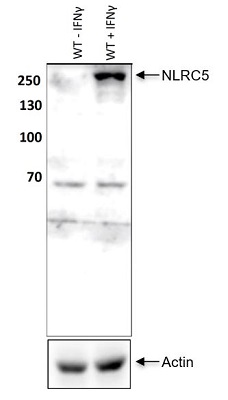anti-NLRC5 (mouse) pAb (IN113)
| Code | Size | Price |
|---|
| AG-25B-0038-C100 | 100 ug | £200.00 |
Quantity:
Prices exclude any Taxes / VAT
Overview
Host Type: Rabbit
Antibody Clonality: Polyclonal
Regulatory Status: RUO
Target Species: Mouse
Application: Western Blot (WB)
Shipping:
BLUE ICE
Storage:
Short Term: +4°C Long Term: -20°C
Images
Documents
Further Information
Alternate Names/Synonyms:
NOD-like Receptor Family CARD Domain Containing 5; Caterpiller Protein 16.1; NOD4; Nucleotide-binding Oligomerization Domain Protein 4
Concentration:
1mg/ml
EClass:
32160000
Form (Short):
liquid
Formulation:
Liquid. In PBS containing 10% glycerol and 0.02% sodium azide.
Handling Advice:
After opening, prepare aliquots and store at -20°C.Avoid freeze/thaw cycles.
Immunogen:
Recombinant mouse NLRC5 (CARD domain).
Long Description:
Polyclonal Antibody. Recognizes full-length mouse NLRC5. Does not cross-react with human NLRC5. Application: WB. Source: Rabbit. Liquid. In PBS containing 10% glycerol and 0.02% sodium azide. Major histocompatibility complex class I molecules are expressed in all nucleated cells, whereas MHC class II molecules are mostly expressed in hematopoietic cells. The tight regulation of both MHC class I and class II molecules is crucial for eliciting an appropriate immune response. The MHC class II and class I molecule regulation is controlled by class II MHC transactivator (CIITA) and by NLR family caspase recruitment domain?containing 5 (NLRC5), respectively. NOD-like receptor family CARD domain containing 5 (NLRC5) is the largest member of the NOD-like receptors (NLRs) family. As all NLR-family members, NLRC5 shares a similar protein structure consisting of three main domains: a variable N-terminal protein-interaction domain, a central Nucleotide-Binding Domain (NBD) and a C-terminal stretch consisting of Leucine Rich Repeats (LRRs). NLRC5 contains between its CARD and NBD domain a bipartite-type nuclear localization signal (NLS), allowing NLRC5 transport towards the nucleus. The expression levels of NLRC5 and MHC class I are highly correlated, with more NLRC5 resulting in more MHC class I expression and increased MHC class I cell surface levels. NLRC5 is highly expressed in hematopoietic cells and tissues such as the spleen, lymph node, thymus, intestine, lung and bone marrow. NLRC5 is inducible by interferon?gamma (IFN?gamma). NLRC5 is decreased in tumor tissues of most cancer types. Lower NLRC5 expression is associated with reduced survival in melanoma, rectal, bladder, uterine, cervical and head/neck cancer.
NCBI, Uniprot Number:
C3VPR6
Package Type:
Plastic Vial
Product Description:
Major histocompatibility complex class I molecules are expressed in all nucleated cells, whereas MHC class II molecules are mostly expressed in hematopoietic cells. The tight regulation of both MHC class I and class II molecules is crucial for eliciting an appropriate immune response. The MHC class II and class I molecule regulation is controlled by class II MHC transactivator (CIITA) and by NLR family caspase recruitment domain-containing 5 (NLRC5), respectively. NOD-like receptor family CARD domain containing 5 (NLRC5) is the largest member of the NOD-like receptors (NLRs) family. As all NLR-family members, NLRC5 shares a similar protein structure consisting of three main domains: a variable N-terminal protein-interaction domain, a central Nucleotide-Binding Domain (NBD) and a C-terminal stretch consisting of Leucine Rich Repeats (LRRs). NLRC5 contains between its CARD and NBD domain a bipartite-type nuclear localization signal (NLS), allowing NLRC5 transport towards the nucleus. The expression levels of NLRC5 and MHC class I are highly correlated, with more NLRC5 resulting in more MHC class I expression and increased MHC class I cell surface levels. NLRC5 is highly expressed in hematopoietic cells and tissues such as the spleen, lymph node, thymus, intestine, lung and bone marrow. NLRC5 is inducible by interferon-gamma (IFN-gamma). NLRC5 is decreased in tumor tissues of most cancer types. Lower NLRC5 expression is associated with reduced survival in melanoma, rectal, bladder, uterine, cervical and head/neck cancer.
Purity:
>95% (SDS-PAGE)
Source / Host:
Rabbit
Specificity:
Recognizes full-length mouse NLRC5. Does not cross-react with human NLRC5.
Transportation:
Non-hazardous
UNSPSC Category:
Primary Antibodies
UNSPSC Number:
12352203
Use & Stability:
Stable for at least 1 year after receipt when stored at -20°C.



